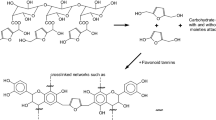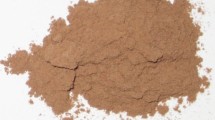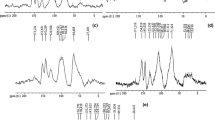Abstract
The suitability of hot water extracted tannins from the bark of Pinus brutia from Turkey as a binder either alone or in combination with phenol formaldehyde was examined. Using formaldehyde-hydrochloric acid about 77% of the active phenolic components could be precipitated. Because of the high molecular weights of the polyphenols only small amounts of formaldehyde were necessary for a complete curing. On the basis of the tannin along with a hardener, such as paraformaldehyde or hexamethylenetetramine, boiling-water-resistant gluing of beechwood panels was obtained (DIN 53254, DIN 68602). Electron microscopical and microanalytical studies of such tannin-bonded panels showed the localization of the adhesive, penetration of the adhesive into the wood cells as well as the interaction between the tannin adhesive and the wood cell walls.
Zusammenfassung
Die Eignung der Rindenphenole von Pinus brutia aus der Türkei für Verwendung als Bindemittel allein, oder auch in Kombination mit Phenolformaldehydharz wurde an mit diesen Mitteln verleimten Buchenvollholzbrettern unter Anwendung makro- und mikrotechnologischer Methoden untersucht. Bedingt durch die hohen Molekulargewichten notwendig, um eine vollständige Aushärtung der Leimfuge zu erzielen. Bereits unter Anwendung von 90% Tannin und 10% Phenolharz in Kombination mit Paraformaldehyd bzw. Hexamethylentetramin als Härter konnten kochfeste Verleimungen von Buchenvollholzbrettern nach DIN 53254 und DIN 68602 erzielt werden. Die Scherfestigkeiten waren höher als die geforderten Norm-Werte. Die mikrotechnologischen Untersuchungen zeigten den Einfluß des pH-Wertes des Leimes auf die Leimfugenbildung und-verteilung. In bezug auf die Preßtemperatur (110/200°C) konnte keine nachteilige Wirkung auf die Leimfuge festgestellt werden. Anhand mikroanalytischer Verfahren wurde eine Eindringung des Tannin-Leimes in die benachbarten Holz-Zellwände nachgewiesen, womit die Fließfähigkeit des Leimes den kommerziellen Phenolharzen gleichkommt.
Similar content being viewed by others
Literature
Bosshard, H.H. 1960: Fluoreszenzmikroskopische Untersuchungen in Spanplatten. Beih. Z. f. Schweiz. Forstw. 30: 13–21
Dalton, L.K. 1950: Tannin-formaldehyde adhesives for wood. Austr. J. Appl. Sci. 1: 54–70
Dalton, L.K. 1953: Resins from sulphited tannins as adhesives for wood. Austr. J. Appl. Sci. 4: 136–145
Deppe, H.J. 1978: Forst- und Holzwirtschaft in Südafrika. Teil 2. Interessante Entwicklungen im Bereich der Spanplatten. Holz-Zbl. 104: 2295–2296
DNA 1979. DIN 68602 (1979): Evaluation of adhesives for jointing of wood and derived timber products: strain groups, strength of bond
DNA 1980: DIN 53254 (1980): Testing of wood adhesives and glued wood joints: determination of shear strength of lap joints
Fengel, D.; Kumar, R.N.: 1970: Electron microscopic studies of glued wood joints. Holzforschung 24: 177–181.
Foss, K.G.; Fuhrmann, A. 1979: Finnish plywood, particleboard and fiberboard made with a lignin-base adhesive. Forest Prod. J.29 (7): 39–43
Futo, L.P. 1973: Elektronenmikroskopische Direktabbildung von Leimfugen und Oberflächenbeschichtungen der Holzwerkstoffe. Holz Roh-Werkstoff 31:177–181
George, J.G. 1977: Annotated bibliography on the research done on the use of naturally occurring adhesives for wood processing industries. UNIDO Workshop on adhesive used in the wood processing Industrices Vienna, Austria
Harada, H.; Furukawa, I. 1972: An electron microscopic observation on the thermal deterioration of glue line in wood. Bull. Kyoto Univ. For. no. 43: 320–327
Hare, D.A.; Kutscha, N.P. 1974: Microscopy of Eastern Spruce plywood gluelines. Wood Sci. 6:294–304
Hemingway, R.W. 1978: Adhesives from southern pine bark—a review of past and current approaches to resin formulation problems. In: C.W. McMillin (ed.) Complete tree utilization of southern pine, Proc. Symp. pp. 442–457, Madison, Wisc. USA
Hemingway, R.W.; McGraw, G.W. 1977: Southern pine bark polyflavonoids. Structure, reactivity, use in wood adhesives. Proc. Tappi Forest Biology: Wood Chemistry Symposium Madison, Wisc. pp. 261–268.
Koran, Z.; Vasishth, R.C. 1972: Scanning electron microscopy of plywood glue lines. Wood and Fiber 3: 202–209
Kruse, J.; Parameswaran, N 1978: Mikrotechnologische Untersuchungen an Rindenplatten. Holz Roh-Werkstoff 36: 225–233
McCoy, J.P.A. 1918: Process of hardening phenolic condensation products. U.S.A. Patent 1,269,627.
Nearn, W.T. 1974. Applications of the ultrastructure concept in industrial wood products research. Wood Sci. 6: 285–293
Olsson, M.T. 1978: Undersökningar över bioelement i bark frangran, tall och björk. Rapporter i skogeskologi och skoglig marlkära, no. 32, 80 pp. Uppsala, Sweden
Parameswaran, N.; Bröker, F.W.; Simatupang, M.H. 1977: Zur Mikrotechnologie mineralgebundener Holzwerkstoffe—Wechseiwirkung zwischen Bindemitehl und Holz. Holzforschung 31: 173–178
Parameswaran, N.; Himmelreich, M. 1979: Mikrotechnologische Untersuchungen an Sulfitablauge-gebundenen Holzwerkstoffen. Holz Roh-Werkstoff 37: 57–64
Pizzi, A. 1978: Wattle-base adhesives for exterior grade particle-boards. Forest Prod. J. 28 (12): 42–47
Plomley, K. F. 1966. Tannin-formaldehyde adhesives. II. Wattle tannin adhesives. Div. For. Prod. Techn. Paper No. 39
Reynolds, E.S. 1963: The use of lead citrate at high pH as an electron opaque stain in electron microscopy. J. Cell. Biol. 17: 208–213
Roffael, E. 1979: Forschritte in der Verwendung von Sulfitablaugen als Binde- und Zusatzmittel bei der Herstellung von Holzspanplatten. Adhäsion [11/12]: 334–336: 368–370.
Roux, D.G. Ferreira, D.; Hundt, H.K.L.; Malan, E.; 1975: Structure, stereochemischy and reactivity of natural condensed tannins as basis for their extended industrial application Appl. Polymer Symp. 28: 335–353
Saayman, H.M.; Oatley, J.A. 1976: Wood adhesives from wattle bark extract. Forest Prod. J. 26 (12): 27–33.
Smith, L.A. 1971: Resin penetration of wood cells walls-implications for adhesion of polymers to wood. Ph. D. Thesis, State Univ. of New York, Syracuse, N. Y.
Smith, L.A.; Côté, W.A. 1971: Studies of penetration of phenol-form-aldehyde resin into wood cell walls with the SEM and energy-dispersive x-ray analyzer. Wood a. Fiber 3: 56–57
Spurr, A.R. 1969. A low viscosity epoxy resin embedding medium for electron microscopy. J. Ultrastr. Res. 26: 31–43
Troughton, G.W. 1967. Kinetic evidence for covalent bonding between wood and formaldehyde glues. Information Report VP-X-26, Forest Prod. Lab. Vancouver, Canada
Weißmann, G.; Ayla, C. 1980: Untersuchung der Rindenextrakte von Pinus brutia Ten. Holz Roh-Werkstff 38: 303–308
White, M.S.; Ifju, G.; Johnson, J.A.: 1977: Method of measuring resin penetration into wood. Forest Prod. J. 27 (7): 52–54
Wilson, J.B.; Krahmer, R.L. 1976: Particleboard: microscopic observations of resin distribution and board fracture. Forest Prod. J. 26 (1): 42–45.
Zündorf, R. 1967: Erfahrung mit der Tesafilm-Methode beim Schneiden schwieriger Objekte. Mikrotomaschr. 4: 130–133
Author information
Authors and Affiliations
Additional information
Presented at the IUFRO Meeting, Subject Group: Wood Processing, Oxford, March 1980
Acknowledgements: We are thankful to Prof. Dr. D. Noack for putting the testing laboratory facilities of the Institut für Holzphysik und mechanische Technologie des Holzes at our disposal. Appreciation is expressed to Frl. B. Schroeder, Frl. R. Schultze and Frl. S. Heinrichs for their technical assistance.
Rights and permissions
About this article
Cite this article
Ayla, C., Parameswaran, N. Macro- and microtechnological studies on beechwood panels bonded with Pinus brutia bark tannin. Holz als Roh-und Werkstoff 38, 449–459 (1980). https://doi.org/10.1007/BF02610428
Issue Date:
DOI: https://doi.org/10.1007/BF02610428




